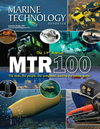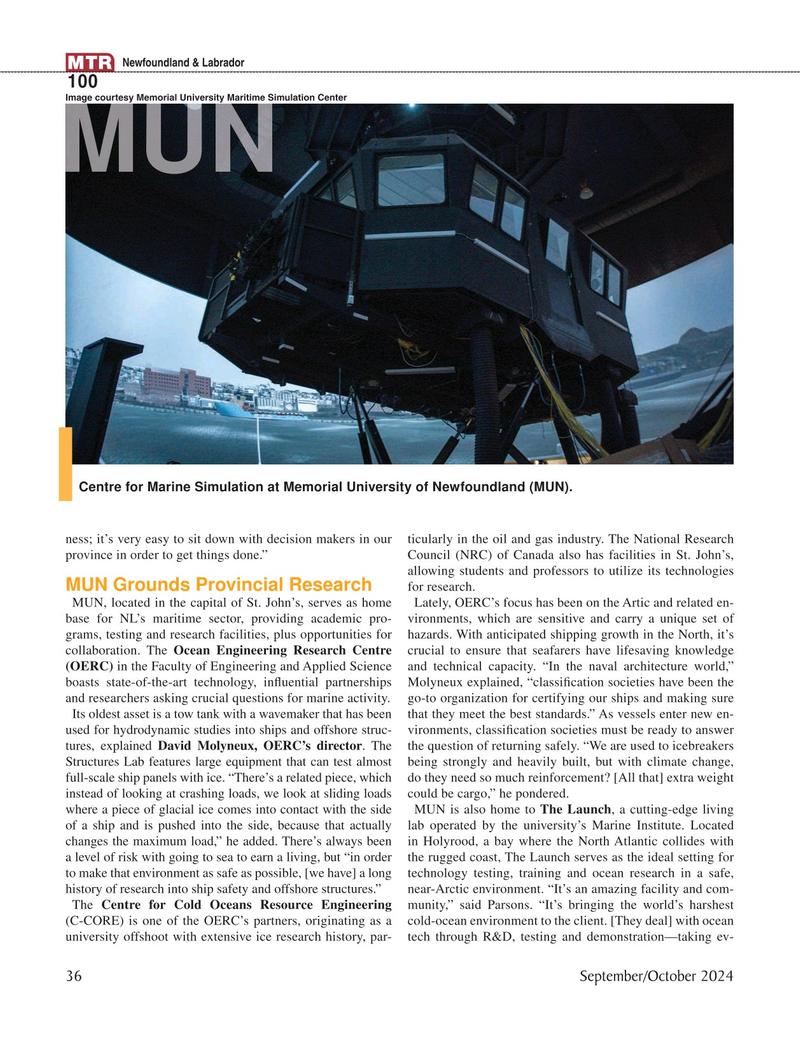
Page 36: of Marine Technology Magazine (September 2024)
Read this page in Pdf, Flash or Html5 edition of September 2024 Marine Technology Magazine
Newfoundland & Labrador
MTR 100
Image courtesy Memorial University Maritime Simulation Center
MUN
Centre for Marine Simulation at Memorial University of Newfoundland (MUN).
ness; it’s very easy to sit down with decision makers in our ticularly in the oil and gas industry. The National Research province in order to get things done.” Council (NRC) of Canada also has facilities in St. John’s, allowing students and professors to utilize its technologies
MUN Grounds Provincial Research for research.
MUN, located in the capital of St. John’s, serves as home Lately, OERC’s focus has been on the Artic and related en- base for NL’s maritime sector, providing academic pro- vironments, which are sensitive and carry a unique set of grams, testing and research facilities, plus opportunities for hazards. With anticipated shipping growth in the North, it’s collaboration. The Ocean Engineering Research Centre crucial to ensure that seafarers have lifesaving knowledge (OERC) in the Faculty of Engineering and Applied Science and technical capacity. “In the naval architecture world,” boasts state-of-the-art technology, in? uential partnerships Molyneux explained, “classi? cation societies have been the and researchers asking crucial questions for marine activity. go-to organization for certifying our ships and making sure
Its oldest asset is a tow tank with a wavemaker that has been that they meet the best standards.” As vessels enter new en- used for hydrodynamic studies into ships and offshore struc- vironments, classi? cation societies must be ready to answer tures, explained David Molyneux, OERC’s director. The the question of returning safely. “We are used to icebreakers
Structures Lab features large equipment that can test almost being strongly and heavily built, but with climate change, full-scale ship panels with ice. “There’s a related piece, which do they need so much reinforcement? [All that] extra weight instead of looking at crashing loads, we look at sliding loads could be cargo,” he pondered. where a piece of glacial ice comes into contact with the side MUN is also home to The Launch, a cutting-edge living of a ship and is pushed into the side, because that actually lab operated by the university’s Marine Institute. Located changes the maximum load,” he added. There’s always been in Holyrood, a bay where the North Atlantic collides with a level of risk with going to sea to earn a living, but “in order the rugged coast, The Launch serves as the ideal setting for to make that environment as safe as possible, [we have] a long technology testing, training and ocean research in a safe, history of research into ship safety and offshore structures.” near-Arctic environment. “It’s an amazing facility and com-
The Centre for Cold Oceans Resource Engineering munity,” said Parsons. “It’s bringing the world’s harshest (C-CORE) is one of the OERC’s partners, originating as a cold-ocean environment to the client. [They deal] with ocean university offshoot with extensive ice research history, par- tech through R&D, testing and demonstration—taking ev- 36 September/October 2024
MTR #7 (34-49).indd 36 10/3/2024 12:13:57 PM

 35
35

 37
37
